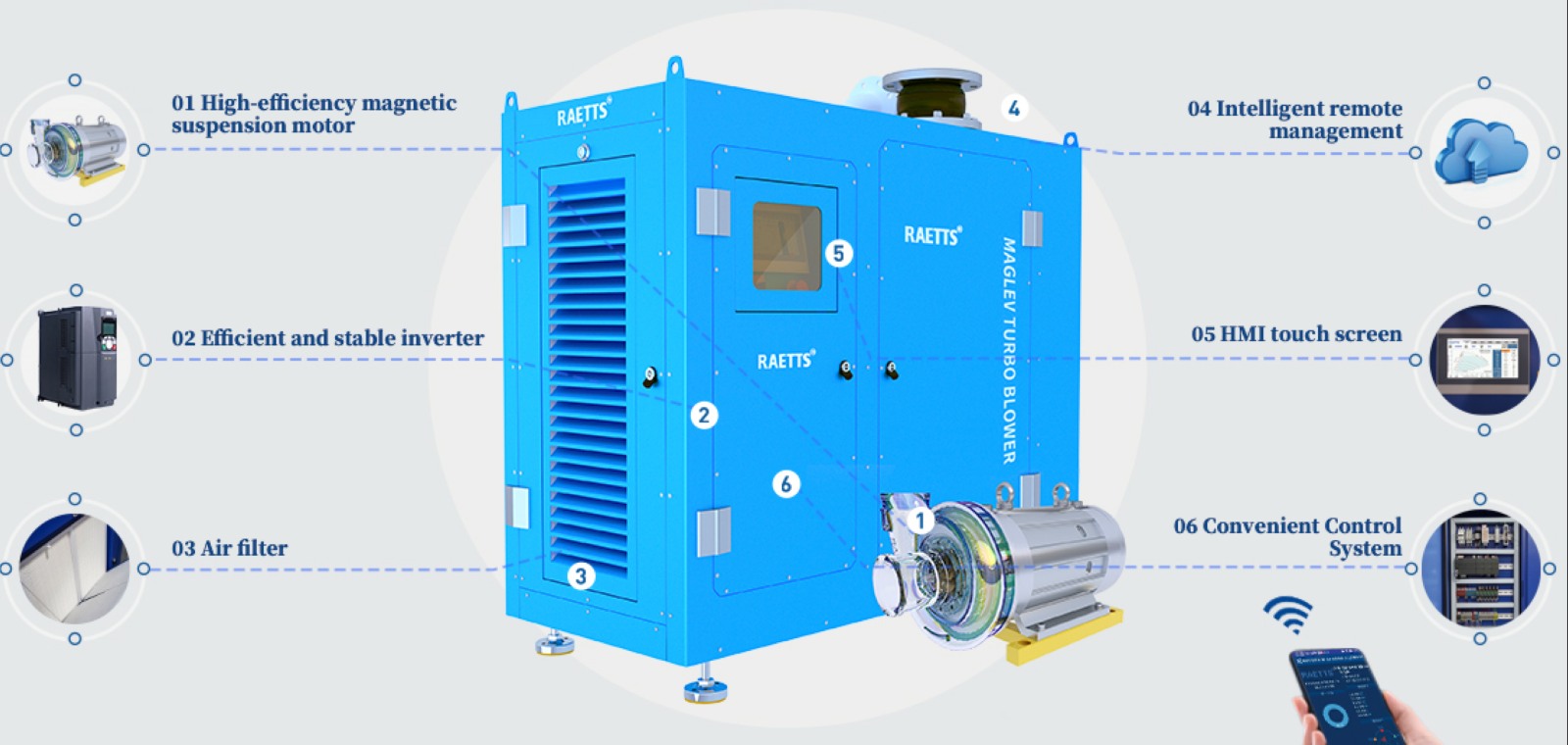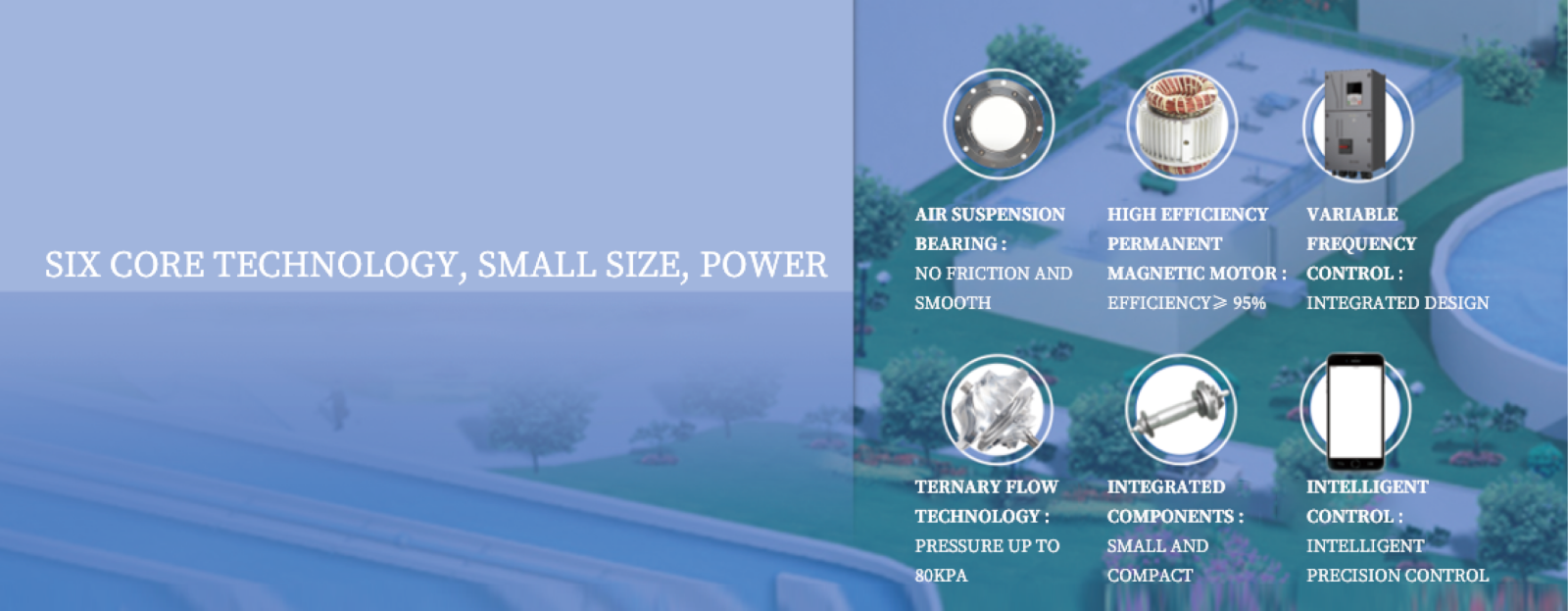RAETTS is a manufacturer of blowers, such as gearless (high speed) turbo blower,air blower for sewage treatment plant,Industrial Blowers for Textile industry,Turbo Blowers for Paper & Pulp. The products are widely used in pharmaceutical and other industries. The company has advanced testing equipment and production facilities, has more than 18 years of manufacturing experience, is very skilled in design, development and manufacturing, and has been exported to more than 30 countries.We can provide more energy conservation for the world, provide more perfect product solutions for customers, and provide good quality and highly competitive prices through mass production. We hope that all customers can provide 100% satisfactory solutions for fans and motors. Welcome more customers from all walks of life to contact us to create a common success in future business relations. We offer the best products and services at the most favorable prices.

| Product name | air blower for Textile industry |
| Keyword | gearless (high speed) turbo blower,air blower for sewage treatment plant,Industrial Blowers for Textile industry,Turbo Blowers for Paper & Pulp |
| Place of Origin | China |
| Feature | RAETTS air bearing turbo blower is a brand-new concept blower, which integrates the main core technologies such as “air suspension bearing”, “permanent magnet ultra-high-speed motor”, “high-precision aviation-grade impeller”, and creates a new era of ultra-high efficiency ,low noise and low energy consumption. |
| Dimensions | 753mm*800mm*796mm, (Contact us for specific information to confirm) |
| Applicable Industries | pharmaceutical, etc. |
| Weight | 350kg |
| delivery date | the common delivery time will be 30-40 days. |
| terms of paymen | RAETTS accept payment by T/T(30% advance payment,70% before shipment) |
| Life span | 18 years (Contact us for specific information to confirm) |
| After-sale service | RAETTS warranty time for air bearing blower and maglev turbo blower is 24months,for high speed centrifugal blower is 12 months. |
| Advantage | We keep good quality and competitive price to ensure our customers benefit |
| Packing | 818x840x813mm(Contact us for specific information to confirm) |
| OEM/ODM | Customization Service Provided |
| Sales country | All over the world for example:Solomon Islands,Guadeloupe,Tajikistan,Holy See (Vatican City),Morocco |
| MOQ | 3pcs(Contact us for specific information to confirm) |
| production capacity | production capacity RAETTS production quantity for air bearing blower and maglev turbo blower is about 200pcs/month,for high speed centrifugal blower is about 700pcs/month. |
| raw materials | RAETTS air blower impeller in made of aluminum alloy,enclosure material is carbon steel,rotor material is cast iron.If customers need other special materials,we can also customized according to customers requirements |
| technology | RAETTS air bearing blower technology is originated from South Korea and maglev turbo blower technology is originated from Germany.RAETTS also have R&D team from Xi’an Jiaotong University |
| quality system | RAETTS has quality management system certificate ISO9001:2015 and enviromental management system certificate ISO14001:2015 |



air blower for Textile industry services FAQs Guide
Are you looking for a quick review guide about air blower for Textile industryservices?
An ultimate FAQ buying guide is available to help you.This guide contains all the information about all the important facts, figures, and various processes regarding air blower for Textile industry services.
Let’s continue!
2.How to choose the right air blower for Textile industry for your specific needs?
3.What is the Overall Efficiency Rating of a Turbo Blower?
4.Are There Different Sizes of Turbo Blowers Available?
5.What Measures are in Place for Protecting Against Overloading a Turbo Blower?
6.How Does a Variable Speed Drive Affect a Turbo Blower’s Performance?
7.How does an air blower for Textile industry work?
8.About air blower for Textile industry air blower origin
9.Can a Turbo Blower Handle Abrasive or Corrosive Gases?
1.About the scale of air blower for Textile industry factory
For now,RAETTS has 3 factory:
Ganzhou standard product production base:30000m2;
Dongguan R&D product production base:20000m2;
Germany production base:2000m2;
2.How to choose the right air blower for Textile industry for your specific needs?
General speaking,we will do model selection of air blower according to customer’s required air flow,air pressure,application,installation altitude,suction media.
3.What is the Overall Efficiency Rating of a Turbo Blower?
We are a new air blower for Textile industry manufacturer.
The overall efficiency rating of a turbo blower can vary depending on the specific model and manufacturer. However, on average, turbo blowers have an overall efficiency rating of around 70-80%. This means that for every 100 units of energy input, the turbo blower can produce 70-80 units of output energy. Factors such as design, size, and operating conditions can also affect the efficiency of a turbo blower.
4.Are There Different Sizes of Turbo Blowers Available?
We have a first -class management team, and we pay attention to teamwork to achieve common goals.
Yes, there are different sizes of turbo blowers available. The size of a turbo blower is typically determined by its flow rate and pressure capabilities. Some common sizes of turbo blowers include:
1. Small turbo blowers: These are typically used for low flow rate and low pressure applications, such as in small wastewater treatment plants or for aeration in fish tanks. They can have flow rates of up to 500 cubic feet per minute (CFM) and pressure capabilities of up to 10 pounds per square inch (psi).
2. Medium turbo blowers: These are used for medium flow rate and pressure applications, such as in medium-sized wastewater treatment plants or for pneumatic conveying systems. They can have flow rates of up to 2,000 CFM and pressure capabilities of up to 20 psi.
3. Large turbo blowers: These are used for high flow rate and pressure applications, such as in large wastewater treatment plants or for industrial processes. They can have flow rates of up to 10,000 CFM and pressure capabilities of up to 30 psi.
The size of a turbo blower can also vary depending on the manufacturer and specific model. It is important to select the right size of turbo blower for your specific application to ensure optimal performance and efficiency.
5.What Measures are in Place for Protecting Against Overloading a Turbo Blower?
We continue to improve air blower for Textile industry products and processes to improve efficiency.
1. Design and Engineering: Turbo blowers are designed and engineered to withstand a certain amount of load and stress. The design includes factors such as material strength, bearing capacity, and rotor dynamics to ensure that the blower can handle the expected load without failure.
2. Load Monitoring: Most turbo blowers are equipped with load monitoring systems that continuously measure the load on the blower. This allows operators to keep track of the load and make adjustments if necessary to prevent overloading.
3. Safety Margins: Turbo blowers are designed with safety margins to account for unexpected increases in load. These safety margins provide a buffer to prevent overloading and protect the blower from damage.
4. Control Systems: Advanced control systems are used to regulate the speed and flow of the blower. These systems can adjust the blower’s output to match the required load, preventing overloading.
5. Vibration Monitoring: Vibration monitoring systems are used to detect any abnormal vibrations in the blower. Excessive vibrations can be an indication of overloading, and the system can automatically shut down the blower to prevent damage.
6. Temperature Monitoring: Turbo blowers generate a lot of heat, and excessive heat can be a sign of overloading. Temperature monitoring systems can detect any abnormal increases in temperature and shut down the blower to prevent damage.
7. Regular Maintenance: Regular maintenance and inspections are crucial for identifying any potential issues that could lead to overloading. This includes checking for wear and tear, lubrication levels, and any other signs of damage.
8. Training and Education: Proper training and education of operators is essential for preventing overloading. Operators should be familiar with the blower’s capabilities and know how to operate it within its limits to avoid overloading.
6.How Does a Variable Speed Drive Affect a Turbo Blower’s Performance?
We focus on innovation and continuous improvement to maintain a competitive advantage.
A variable speed drive (VSD) can have a significant impact on a turbo blower’s performance. Here are some ways in which a VSD can affect a turbo blower:
1. Energy Efficiency: One of the main benefits of using a VSD with a turbo blower is improved energy efficiency. By adjusting the speed of the blower to match the required air flow, a VSD can reduce the amount of energy consumed by the blower. This is because the blower does not have to run at full speed all the time, which can result in significant energy savings.
2. Improved Control: A VSD allows for precise control over the speed of the blower, which in turn allows for better control over the air flow. This is especially useful in applications where the air flow requirements vary, as the blower can be adjusted to meet the changing demands.
3. Reduced Wear and Tear: Running a turbo blower at full speed all the time can put a lot of strain on the equipment, leading to increased wear and tear. By using a VSD, the blower can be operated at lower speeds when the demand is lower, reducing the strain on the equipment and extending its lifespan.
4. Noise Reduction: Turbo blowers can be quite noisy when running at full speed. By using a VSD to adjust the speed of the blower, the noise level can be reduced significantly. This is especially beneficial in applications where noise levels need to be kept to a minimum.
5. Improved Process Control: In some applications, the air flow requirements may need to be adjusted constantly to maintain a specific process condition. A VSD allows for precise control over the air flow, making it easier to maintain the desired process conditions.
In summary, a variable speed drive can have a positive impact on a turbo blower’s performance by improving energy efficiency, control, reducing wear and tear, noise levels, and improving process control. It is a valuable tool for optimizing the performance of a turbo blower in various applications.
7.How does an air blower for Textile industry work?
The main structure of the air blower is including motor,shaft,bearing and impeller.When the motor is running,it will drive the shaft to run,then shaft drive bearing to run,then bearing drive the impeller to run.After the impeller runs,it will generate a vacuum area surrounding the impeller and suck the surrounding air inside.Then the air will be compressed by the impeller and discharged outside.
8.About air blower for Textile industry air blower origin
RAETTS air blower is made in China and made in Germany,we have factory both in China and Germany.
9.Can a Turbo Blower Handle Abrasive or Corrosive Gases?
We have established a good reputation and reliable partnerships within the air blower for Textile industry industry.
It depends on the specific design and materials used in the turbo blower. Some turbo blowers are designed to handle abrasive or corrosive gases, while others may not be suitable for these types of gases. It is important to consult the manufacturer’s specifications and recommendations before using a turbo blower with abrasive or corrosive gases. Additionally, regular maintenance and proper cleaning may be necessary to ensure the longevity and performance of the turbo blower when handling these types of gases.
Tag:magnetic suspension blower for Textile ,Cement factory blower,RAETTS Turbo Blower,air suspension blower,Centrifugal Blowers are Versatile Solutions,air turbo blower








